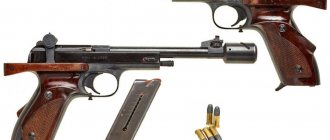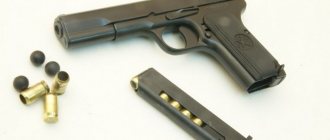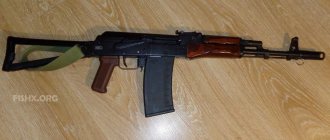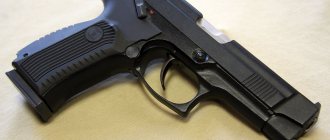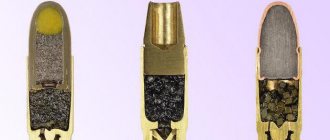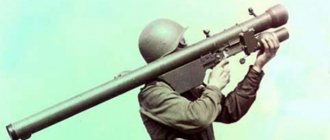The 9x18 PM cartridge was adopted by the Soviet army and law enforcement agencies in 1951. The ammunition came to replace the more powerful 7.62x25 TT, which had excessive bullet penetration and was poorly suited for use by the police. At the same time as the cartridge, they began producing a Makarov pistol for it.
Today, 9x18 mm PM is widely used throughout the world. In particular, it is used throughout the post-Soviet space and by a number of countries of the former Warsaw Pact. The ammunition continues to be regularly modernized to suit modern realities. For example, in 2005, the PPO (law enforcement cartridge) was adopted, which has low ricochetability and is produced by the Tula Arms Plant.
This ammunition is also actively used in all countries where the USSR supplied weapons. Licenses for full-fledged production were sold there. The same China continues to produce it in huge quantities for its own needs and for sale to other countries.
PM cartridge - device
This modification of the cartridge is a unitary product. It has a wafer sleeve in the shape of a cylinder. Cartridge parameters: 7.62×25 mm TT. it was developed by the outstanding Russian designer B.V. Semin back in 1951. PM cartridges have a unique design that is not repeated in exact proportions in any other product. Many modern designers take the drawings of these shells as the basis for new developments. Basic moments:
- The sleeve is made of bimetal. It has a standard shell shape.
- The core inside is made of steel, its shape is mushroom-shaped. It is pressed into a lead shell and primer, which contains a powder charge.
- Caliber 9 mm. Ammunition size - 7.62x25 mm TT. Can be used in weapons with a simpler mechanism. Suitable for guns with a blowback action or short barrel stroke.
The first version of this ammunition was created from brass alloys, and the core was made not of steel, but of lead. It is important that the shell was steel. The new modification significantly saves production costs and increases the bullet's penetration ability. Especially if we are not talking about metal targets. The ammunition does not have the ability to penetrate body armor, because when it hits the metal, the shell is destroyed, and the core has a special shape, so it rebounds. The obstacle is not broken through, but characteristic marks may remain on the surface.
back in 1994, it created a special variation of PM cartridges: a 9x18 mm cartridge model with an expansive version of the bullet, which penetrates the target through and does not ricochet. These cartridges have a high power rating and a heavy case. It is 2 grams more than conventional projectiles.
Usage
Let's start this section with one of the famous, but extremely revealing stories about our pistol. One of the first Makarovs, produced in 1949, continued to be in service as of 2004. This barrel fired over 50 thousand shots (talking about reliability and application).
Upgraded version of the PMM with a 12-round magazine
The pistol was and is in service in several dozen countries around the world. Produced in China, North Korea, and ATS countries. It is perhaps difficult to find a conflict where this pistol would not take part.
By the beginning of the 21st century, the PM found a replacement in the person of much more modern brothers: PYa, SR-1, GSh-18 and others, each with its own niche of application. Nevertheless, on the streets of our cities you still meet police officers armed with a convenient and unpretentious PM. Despite all the innovations, as they say, the old horse will not spoil the furrow, and the PM continues to be successfully used by operatives and police officers. Separately, the popularity of PM in the USA should be mentioned. A very convenient and compact pistol for self-defense has gained great popularity in the civilian market.
The Makarov pistol
From all of the above, we can confidently say that the Makarov pistol, which has served for almost 70 years, will serve another 50, if not more. We think you'll agree with this.
Cover: pinterest.ru
Characteristics of the cartridge
The Makarov ammunition was created taking into account the impossibility of using it with the 9x19 mm Parabellum cartridge. There is a similar foreign-made ammunition called 9x18 mm Ultra. The parameters of the German cartridge are slightly different from the PM. The German company Geko developed it specifically for arming police inspectors. Their main differences:
- sleeve dimensions;
- power;
- bullet caliber.
If the Soviet ammunition has a calibration of 9.27 mm, then the Ultra is 0.27 mm larger. Detailed characteristics:
| Characteristic | Parameter |
| Caliber | 9 mm |
| Cartridge weight | 10 g |
| Charge mass | Circumference – 0.25 g |
| Bullet weight | 6.1 g |
| Chuck length | 25 mm |
| Bullet length | 12.35 mm |
| Case length | 18.1 mm |
| Loading chamber volume | 0.56 cm3 |
| Maximum gas pressure | 118 MPa (1200 kg/cm2) |
| Bullet speed V10, m/s | From 290 to 435 depending on the type and model |
| Specific energy, J/mm2 | From 4.2 to 7.2 |
The penetration indicator depends on the type of projectile. If this is a regular cartridge or a type of rebound action, then the weight of such a bullet will not exceed 6 grams, and armor-piercing ones will weigh at least 7 g. The volume of the temporary pulsating cavity in the gelatin block, which any variant of PM cartridges has, also depends on the modification, and varies from 293 to 495 cm3.
During manufacturing, each ammunition is checked by technologists. The cartridges are packed in special wooden boxes. Each package contains 2560 pieces. The boxes are folded into boxes that are made of iron or galvanized material. Each box must be signed and labeled. The weight of one box of ammunition is 33 kg.
Notes
- ↑ (inaccessible link). weapon.at.ua. Retrieved August 25, 2010.
- A. I. Blagovestov. What they shoot from in the CIS: Directory of small arms. / edited by A.E. Taras. Minsk, “Harvest”, 2000. p.532-533
- “ Yesterday, Tekhkrim JSC conducted preliminary tests of a pilot batch of the so-called expansive cartridge for pistols of the Makarov family... the new 9 mm cartridge, created on its own initiative, has a significantly greater penetrating and stopping effect
” Lev Ambinder. Police bullets will become police bullets // Kommersant newspaper, No. 16 (484) dated February 1, 1994 - A. I. Blagovestov. What they shoot from in the CIS: Directory of small arms. / edited by A.E. Taras. Minsk, “Harvest”, 2000. p.533-534
Advantages and disadvantages of 9 mm cartridges
This type of ammunition has its pros and cons when compared with similar models or foreign analogues. Most experts believe that PM variant cartridges are universal. It can be used in almost any weapon, as long as the charge of the required power and action is selected.
Advantages and disadvantages
The lead core is soft, which provides the projectile with decent heaviness. It is small in size and fits well into rifling
The durable shell of the projectile guarantees reliable guidance of the bullet along the rifling
Universal sleeve shape. The bullet is placed in it with tension, which is what keeps it from falling out
The charge consists of smokeless pyroxylin powder
The charge can be used to fire from all types of guns that use 9 mm caliber bullets
There are many modifications of cartridges, which allows you to choose any option for specific purposes.
Only high-quality materials are used: steel or brass with good strength
Doesn't penetrate body armor. Has only a stopping effect
There are many fakes of this cartridge on the market.
The initial speed does not correspond to the declared characteristics
Testing has shown that the punching action on a steel sheet has deviations
Some modifications significantly lose energy during firing, but this does not apply to type 57-H-181CM
During testing, it became clear that a distance of more than 15 meters makes the device ineffective. It won't be able to penetrate even a thin sheet of paper.
If the cartridges have been in the box for a long time, this may cause difficulty in loading the magazine.
Before loading the gun, it is important to ensure that the ammunition has no external damage. Deformation may cause the cartridge to become stuck in the magazine or damage the internal mechanism of the device. This will cause the entire gun to malfunction. Despite the fact that most weapons are repairable, it is difficult to carry out these activities without special skills. Moreover, you will need to purchase spare parts, which are not so easy to find on the arms market.
On a note! All shells are marked.
Do I need permission?
Definitely yes! You can obtain permission from the licensing department. You should contact the branch that is located closer to your home. The entire obtaining process can be found at the OLRR office.
Before you start collecting all the necessary documents to obtain a license, you should find out who can apply for a license. The blacklist includes a whole group of people assigned to a special list:
- Minors;
- Persons who have at least one criminal record;
- Persons who have been charged with an administrative violation more than twice;
- People without registration;
- Having serious complications, mental disorders, vision problems;
- Persons who do not have the necessary documents.
If you do not find yourself on this list, you have the right to obtain a permit. The process itself consists of several stages that everyone must go through:
And first you will need to undergo a medical examination at the hospital. For such purposes, you can contact either a paid institution or a free one. The mechanism is very similar to what happens when applying for a driver’s license. Here you will need to purchase a certificate form for 300 rubles. To fill it out, you will have to visit neurological and drug treatment clinics.
To submit an application to the OLRR, you need to prepare a number of documents:
- An official appeal written according to a special form;
- Copy of personal document;
- Certificate from the hospital;
- 3x4 photographs.
Once your application has been approved, you will be provided with the following:
- Referral for weapons handling training;
- Receipt for payment of state duty;
- Direction to the local police officer.
Training in proper handling of weapons is a special test that includes 10 questions. It is worth noting that in order to pass the test successfully, you need to answer 9 out of 10 questions correctly. 2 attempts are provided: one free, the second paid.
When contacting a district police officer, an individual interview and inspection of housing according to registration are required. To register a weapon, you must have a safe or cabinet at home with a two-turn lock. After the local police officer is convinced that your living space is completely safe for storing weapons, he will put his stamp.
After submitting the necessary documents, you will need to wait about a month, after which you should be notified that the application has been approved. After this, you can purchase a traumatic PM with peace of mind. If you receive a refusal and do not agree with it, you can always challenge it in court. It is worth noting that according to the law, you can purchase PM only up to 2 units with complete peace of mind.
Types and parameters of cartridges
Depending on the modification, PM bullets have different parameters, but they all have a lead core. Bullets are produced by Russian factories. Main manufacturers: Novosibirsk Low-Voltage Equipment Plant, Tula Cartridge Plant, Barnaul Machine Tool Plant, organization in Novosibirsk and Klimov. Main variations of PM ammunition:
- The usual variation is called 57-H-181C. This projectile is manufactured with a brass case.
- SP-7 is an ammunition with an expansive bullet.
- There is ammunition with a PPT tracer bullet (57-T-181);
- The 7N15 includes a metal body and an all-metal armor-piercing bullet.
- Ricochet version - 9x18 PRS gs.
- To sell cartridges abroad, they began to create 9x18 PSV (Hollow Point type).
- Training or sports cartridge brand - 9x18 PSO gzh and 9 UCH gzh.
- Blank ammunition and pistol versions are manufactured, which are most often used by law enforcement agencies at the shooting range.
- Armor-piercing shells that have increased mass of each part and power.
- Expansive cartridge (9 SP7 gzh, 9 SP8 gzh, 9 Ppe gzh, 9x18 RG028 gzh).
The characteristics indicate the average indicator of powder gases. Practical studies have shown that this position varies from 103.9 to 147.1 MPa. The average impulse value is no more than 3 N·s. It is worth considering each type in more detail, because even the same model has different characteristics, depending on which plant produced the ammunition. For example, a 9 mm PM cartridge with a lead core is produced for export by several organizations. The bullet weight varies from 6.1 g to 6.86 g, and the initial speed from 303 m/s to 325 m/s.
Other features:
- An expansive projectile can be produced using polyethylene. Special notches are created on the bullets along the entire rim or they are distinguished by a hexagonal hole.
- The expansive version can be produced with a lighter weight, from 4.1 g. The speed indicator varies from 325 m/s to 420 m/s, and the gas pressure during the trigger release is 122.6 MPa.
- SP-8 is designed for firing when minimal destruction of low-strength barriers is necessary. The speed of this ammunition is 255 m/s, and the gas pressure is 78.5 MPa.
- There is a type of 9mm cartridges with a tracer bullet. This type of projectile is designed to have a psychological effect on the enemy and is capable of adjusting fire. Parameters: ammunition weight - 9.6 g; bullet weight - 5.7 g; initial speed – 300 m/s; the tracing range is no more than 150 m, and the offset range is up to 20 m.
- For armor-piercing bullets, the mass of the bullet is 5.9 g, and the muzzle velocity of the ammunition is at least 435 m/s. The gas pressure is also the highest - from 147.1 MPa.
- The 9x18 PS GS PPO model was created specifically for police officers and military personnel of government agencies.
- 9x18 RG028 gzh - high penetration power.
- 9x18 PRS GS is a special ammunition. It doesn't ricochet like others. Also most often used in law enforcement agencies.
- 9x18 PSV was created specifically for export.
- 9x18 PSO gzh is produced for sport or hunting shooting.
The inert version - 9 UCH GZh - is a training type of ammunition or, as experts say, a training type. If the edges of the cartridge case are pressed into a “star” shape, then the cartridge is blank. The most powerful are armor-piercing cartridges. Their weight reaches 7.4 g. They are created for use in small arms. This type of projectile can penetrate an armored or steel plate of 5 mm at a distance of up to 10 m.
The 9x18 mm PMM cartridge is a new projectile with the 7N16 index. It was created specifically to increase the bullet's penetration ability. It has a significantly increased powder charge and uses a new bullet in the shape of a truncated cone. The speed indicator is up to 410-435 m/s, and the kinetic energy: 485-505 J. The designers created a different form of the cartridge, thereby reducing the likelihood of ricochets. At a distance of up to 20 m, it easily penetrates 3 mm steel sheets. These bullets can only be used in a special weapon with a reinforced design. In such weapons as: PMM, OTs-27, “Bisons” and “Cedars”.
There are also subtypes of almost every option. Some types of cartridges are modernized, while others are redesigned, changing the internal structure of the ammunition.
Operation history
The PM remained in service with law enforcement agencies even after the collapse of the USSR in 1991, and continues to be used in a number of countries around the world due to its simplicity and reliability.
At least until 2004, the security of the State Unitary Enterprise Instrument Design Bureau included a serviceable PM pistol manufactured in 1949 (serial number 11) with about 50 thousand rounds fired.
The plot of the movie “Makarov” unfolds around the PM pistol.
Operating countries
- Afghanistan
- Albania
- Angola
- Armenia
- Azerbaijan
- Belarus
- Bulgaria
- Bulgaria
- Vietnam – repair and production of PM pistols has been mastered by the Z111 plant
- GDR
- Georgia
- Indonesia
- Iraq
- Kazakhstan
- Kyrgyzstan
- DPRK
- China
- Cuba
- Laos
- Latvia
- Lithuania
- Malta
- Moldova
- Mongolia
- Mozambique
- Russia - in the army and law enforcement agencies, PMs are gradually replacing the Yarygin pistol, PMM and other new models of pistols, but the PM continues to remain in service.
- North Macedonia
- Syria
- Slovenia
- USSR
- Tajikistan
- Turkmenistan
- Uzbekistan
- Ukraine
- Eritrea
- Estonia - in service with the Estonian armed forces
- Ethiopia
How to properly load a Makarov pistol
PM cartridges have this name because the first version of this ammunition was created specifically for the Makarov pistol. In order to load or unload a Makar weapon, only two steps are required: equipping the magazine with cartridges and removing it, but for beginners, these activities involve some nuances. The process is carried out in a well-lit room. Those who are doing this for the first time should take into account all the points. To quickly charge, you need to follow the following points:
- The pistol is removed from the holster. You need to remove the magazine from the base of the handle and put it aside.
- Then place the pistol in the holster to load the magazine with ammunition (one at a time). For convenience, it is necessary to hold the magazine in the left hand if the person is right-handed, and produce equipment with the left.
- During charging, it is necessary to make a pressing movement with your thumb. It is important that the ammunition goes beyond the upper curved edges of the side walls of the magazine housing.
- Then you need to move it with the capsule close to the rear wall of the case.
- After this, the weapon is removed from the holster and the magazine is inserted into the base of the handle.
In order for the pistol to be ready to fire, it is necessary to place a cartridge in the chamber of the barrel. The safety box is removed, which protects the gun from unauthorized firing. Having lowered the flag up, it is important to move the shutter so that it is in the “back” position. A characteristic click will occur, after which the shutter can be released.
On the contrary, to put the gun on safety, you need to move the flag down so that it covers the red circle. Only after this the weapon is returned to the holster. It is important to consider that discharge has a slightly different algorithm of actions. Instructions on how to unload a pistol:
- Remove your finger from the trigger. Put the gun on safety.
- Remove the magazine from the base of the handle. It is important to ensure that there is no cartridge left in the chamber.
- If the charge is inside, then the cartridge is removed from the chamber. To do this, you need to hold down to pull the bolt back.
- Remove the safety from the pistol because the magazine is removed and there is no danger of a shot.
- The bolt will eject the cartridge to the ground. Other ammunition is removed one by one forward along the magazine feeder. It is important to catch them so that they do not fall to the ground.
Other shells are removed from the magazine one by one. It is necessary to pry each cartridge by the sharp part of the product. It will move up the mechanism with tension, because each ammunition has its own compartment into which it fits quite tightly. During discharging, the removal of each cartridge is accompanied by a characteristic click.
If the product is stuck inside or becomes warped, then you should not try to remove the bullet using metal objects. This may damage the magazine.
Ammunition for PMM
At the end of the 80s of the last century, an army competition began to replace the outdated PM. The participants of the Grach program were contacted with the following requirements:
- The new pistol was supposed to penetrate standard body armor at a distance of 100 m;
- The design must use the most modern materials;
- Improving the overall ergonomics of weapons;
- High technology of products and the possibility of mass production.
At the same time, they were developing several pistols at once. In some cases, they even developed a new pistol-bullet complex (SR-1 and 9x21 mm cartridge). At the same time, an attempt was made to modernize the conventional Makarov Pistol. The project was carried out by designers from the Tula Arms Plant.
To increase penetrating power, the size of the powder charge was increased by 30 percent. The shape of the bullet was changed. As a result, the resulting cartridge received the marking 9x18 PMM or 57-N-181-SM. By increasing the muzzle energy, the bullet became capable of penetrating 1st generation army body armor or hitting a target behind thin cover. For this we had to pay with increased recoil and weight of the weapon.
The most interesting thing is that the standard pistol was not capable of firing this ammunition. Such a cartridge in the PM chamber rendered the product unusable over time. At the same time, a situation with a rupture of the chamber arose and often occurred. To neutralize the negative effect, the PMM Modernized Makarov Pistol was created. The model's barrel and some of the internal mechanisms were strengthened, but this led to an increase in weight and deterioration in ergonomics. Nowadays PMM is rarely used.


